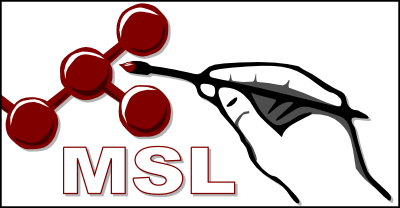Difference between revisions of "Main Page"
(→Main development team:) |
(→Reference) |
||
| Line 51: | Line 51: | ||
'''MSL (including early versions) has been used in the following work:''' | '''MSL (including early versions) has been used in the following work:''' | ||
| − | <pubmed>23520975 23422424 23089864 22576292 22178759 21482808 21287621 21321234 21287621 20945900 20080739 19722646</pubmed> | + | <pubmed>24003111 23520975 23422424 23089864 22576292 22178759 21482808 21287621 21321234 21287621 20945900 20080739 19722646</pubmed> |
Revision as of 21:43, 22 September 2013
Contents
MSL: an open source C++ library for analysis, manipulation, modeling and design of macromolecules.
Philosophy
The main goal is to create a set of tools that enable the computational study of macromolecules with relative ease at all levels, from simple operations (for example, load a PDB and measure a distance or edit a dihedral) to complex applications (protein modeling or design).
The MSL library is not a program (although some applications are distributed) but a tool for scientist to code their own methods.
Features
Some of the features supported by the library are:
- Support for reading and writing PDB and CRD files.
- The ability of storing and switching between multiple atom coordinates, for conformational changes and rotameric representation of side chain conformational freedom.
- For protein design, the ability to build and store multiple residue identities (i.e. LEU, ILE, ALA) at a position and switch between them.
- Support for rotamer libraries.
- Transformations such as translations, rotations, and alignments.
- The CHARMM force field and other energy funtions.
- Support for CHARMM topology and parameter files.
- Structure building from scratch (using internal coordinates)
- Search algorithms such as Monte Carlo, Dead End Elimination, and Self Consistent Mean Field Monte Carlo.
- Local backbone sampling.
- Crystal lattice generation.
- A PyMOL Python Interface for calling MSL code from within PyMOL.
- A R Interface for calling arbitrary R algorithms or plotting routines from within MSL
- And more...
Documentation
The Documentation – currently still under construction – provides a description of the objects and of some distrubuted programs and utilites. A step by step tutorial is being assembled.
Status
Current version: 1.1, released on April 3, 2013.
Previous versions: 1.0, released on July 8, 2012.
Source
The source code can be downloaded on SourceForge. Go to the Download page. ("To do" list).
Main development team:
- Alessandro Senes, Sabareesh Subraminiam, Ben Mueller, Dept. of Biochemistry, U. of Wisconsin-Madison, Senes Lab
- Dan Kulp, IAVI, Scripps Research Institute, La Jolla CA
- Jason Donald, Agrivida, Inc., Medford MA
- Brett Hannigan, U. of Pennsylvania, Genomics and Computational Biology Graduate Group
- Gevorg Grigoryan, James Zhang, Dept. of Computer Science, Dartmouth College, Hanover NH, Grigoryan Lab
Reference
Article published using MSL should cite:
MSL (including early versions) has been used in the following work:
